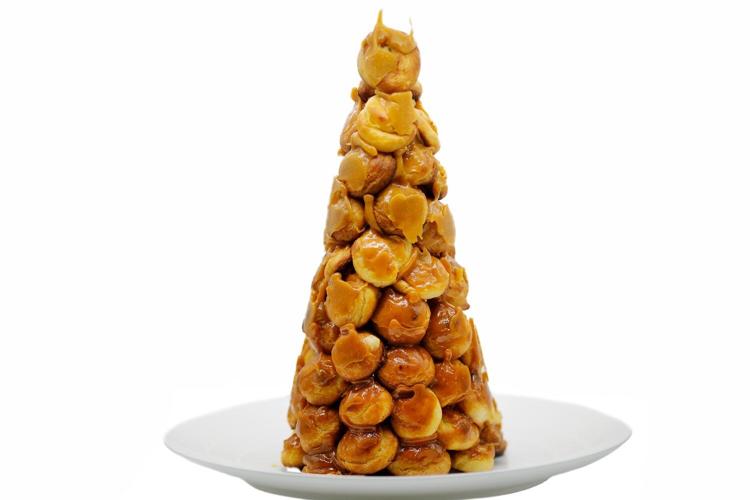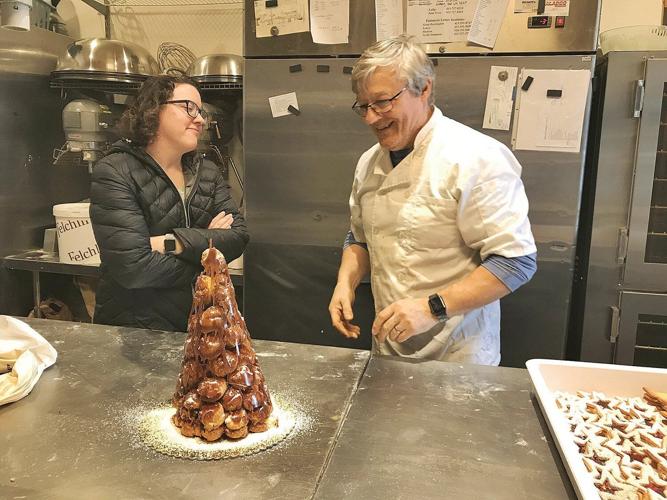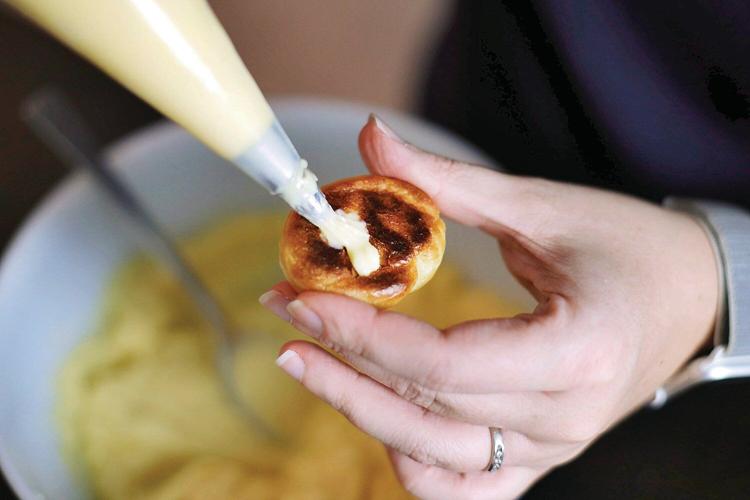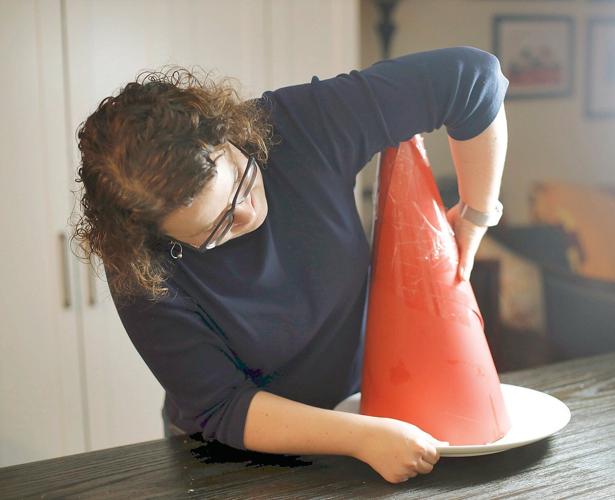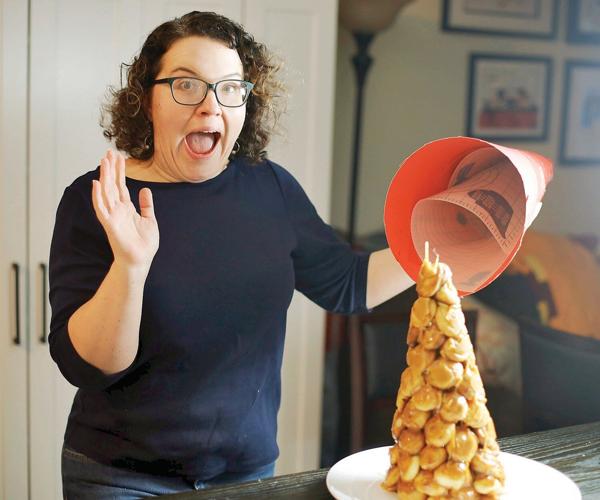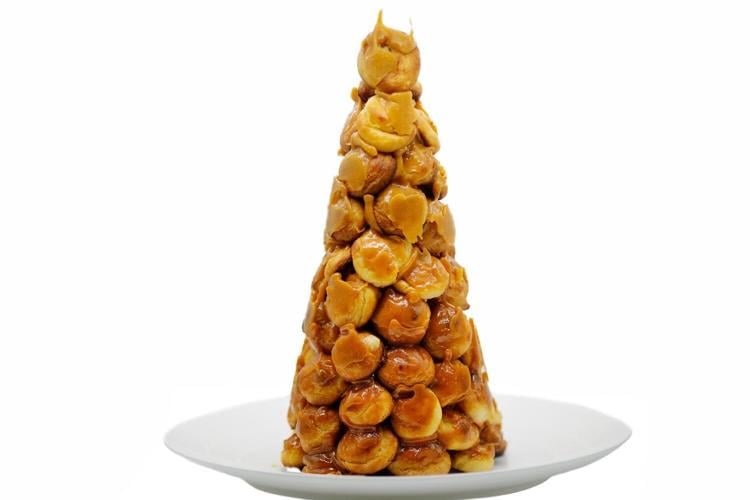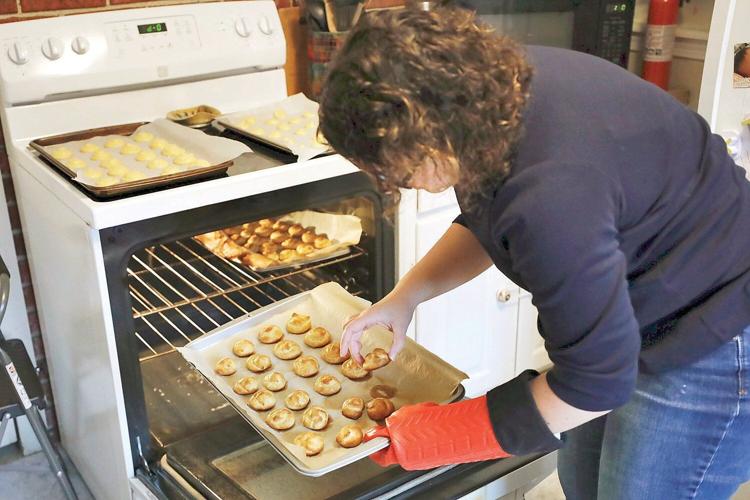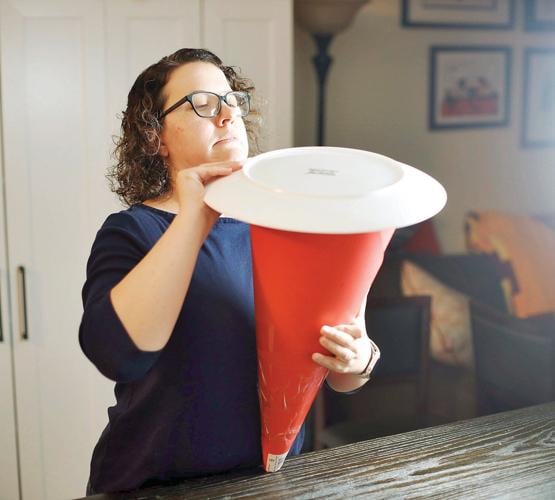Lindsey Hollenbaugh, the managing editor of features, was challenged to make a croquembouche (a tower of cream puffs held together with caramel.) Watch this baking show fan (with a number of office-related baking fails under her belt) attempt to make a French pastry ... Will she triumph?
Read the story here: https://www.berkshireeagle.com/stories/a-very-beginners-guide-on-how-to-make-a-croquembouche,592987
"I want to make a video of you making some kind of food that is extremely difficult."
That's how Eagle photographer Stephanie Zollshan approached me on a recent Tuesday morning, and like any adventurous features editor I replied, "OK, but why?"
"Because it's funny when you screw things up."
Thanks?
But, she's right, it turns out.
At The Eagle, members of the features department take turns making recipes to test out and photograph. It's no secret around the newsroom that when I make things, especially baked goods, they often taste terrific, but don't win any beauty pageants. I'm the home cook who can't get the cake out of the bundt pan, whose frosting looks grainy or drippy, and that "Happy Birthday" message in gel frosting? Forget it.
But I was still game to tackle some outlandish holiday treat in my kitchen for the sake of journalism, because I figured if I can do it, so can our readers.
"How about a croquembouche?" Meggie Baker, our calendar editor who actually makes beautiful things in her kitchen, suggested.
For those of you who, like me, don't know what a croquembouche is, it's a towering French dessert, often made as a wedding or celebration cake, made up of individual choux pastry puffs filled with cream, piled into a cone and bound together with threads of caramel. Piece of cake, right?
I was going to need some help.
Thankfully, executive pastry chef Jean Yves Bougouin of Patisserie Lenox offered to give me a few tips on how to tackle this towering French feat.
But first, how the heck do I say it?
After a few attempts at repeating Bougouin and trying to pronounce his last name, I said, "I don't speak French."
To which he simply replied, with a smile, "I guess not."
"Croquembouche means crack in the mouth," he said, as he paused briefly in his morning routine of making cinnamon rolls in the kitchen of his Great Barrington shop. "Why is that? Because it's Croquembouche and it's all sugar, caramelized and it's hard and soft from the cream, but mostly hard."
When I asked him to "walk me through the basics," the pastry chef who has been doing this work for more than 50 years, audibly laughed at me.
"I thought you already knew how to make a croquembouche and just needed more tips. ... I will show you the beginning, but I will not make the whole thing."
Thankfully, he took pity on this curly-haired woman with little-to-no pastry experience and walked me step by step through the entire process, pausing in the middle of his Christmas rush to show me how to make a French dessert he admitted that even he did not like making.
"I hate doing them, not because they are difficult to make but they are difficult to keep," he said. "In the summer, the sugar just melts; it becomes a mess. In the winter, before Christmas, I don't have time to make them. ... People ask me all the time at Christmas to make them, and I always turn them down."
He wanted to make sure our readers know this lesson in croquembouche is a special exception, and he's still not making them this time of year. (So please don't call him and order one, or I'll make the kind, but very busy, French chef angry.)
So here's how the lesson went:
"Caramel, you must know how to make caramel, no?" He asked.
"No."
Then, he realized that I had never made choux pastry before (pronounced shoe pastry), when he quizzed me about the ingredients of the basic recipe that is used in eclairs, and I didn't answer, just smiled. He paused, smiled back at me and proceeded to make an entire croquembouche to show me how it's done.
I left the bakery with some terrific tips — "When you do them, know you are going to burn your fingers." — but the biggest takeaway was the actual construction of the tower. In every recipe I found online, the baker was instructed to build the croquembouche from the bottom up. Bougouin pointed out the flaw in this advice; for starters, it's not a stable process while the caramel dries, but more importantly, you don't know how many puff pastries you need to get to the top. So, you might have too many or too few, you'll have to go back and start the laborious process of making more filled pastries all over again. Instead, he uses a cone constructed out of poster board that allows you to build it upside down, starting with the top. Then, when you run out of the filled pastries, you flip it over, unveiling, hopefully, a towering tree-like structure.
Armed with this information and what little I've learned from hours of binge-watching "The Great British Baking Show," I set off to my kitchen with little more than one pot — I realized on the day of filming that new pots are on my Santa wishlist since I had thrown out many of my old pots — and a whole lot of eggs.
For the recipe, I used a combination of Bougouin's basic recipe for choux pastry (all the others were "bulls--t" according to him), and a Food Network recipe for a basic filling that had to be made 24 hours before. The filling, closer to a vanilla custard, was simple and delicious. The choux pastry, on the other hand, tested all my silly notions of having superior arm strength as I grunted through mixing 12 eggs into the batter by hand.
After piping the pastry onto the trays in sweet little circles, I checked my notes and realized Bougouin gave no specific time. "I never give times, it depends on the oven," he said.
After a few burned batches, I learned that my oven has hot spots that require constant rotating of the trays. In the end, each batch baked for about 45 minutes. Then it was time to fill each individual pastry with the cream that sat in my fridge overnight. Last, came the most challenging part of the recipe: making the caramel.
Bougouin made it look easy; he simply melted sugar in a bowl on a hot plate and made a dark, syrupy caramel.
"Don't put too much [sugar] in at a time, start very slow, then put a little more in at a time," he warned me during our lesson. By this step, we'd been at this for three hours; I didn't listen, I rushed and my house smelled like burnt caramel for a week. The second batch went much slower, but did produce a medium brown, but thick caramel that I proclaimed was "close enough." I dipped each puff pastry in the caramel and quickly began constructing my tower before the melted sugar quickly hardened. I'm proud to say, I only burnt myself once.
When I flipped over the poster board cone, lined with silicone baking pads, there, somehow but for the grace of the cooking Gods, stood a croquembouche.
After five hours, at least 10 trays of choux pastry, two batches of caramel and the help of one sous chef and a photographer who couldn't watch me burn myself again — oh, and that one lonely pot — we did it. But did it taste good?
I warily carried it into the newsroom, heeding Bougouin's warning about the instability of transport for such a dessert. Once it landed near the printer — our communal place for free food — my peers ripped it apart in minutes. They loved it.
They lavished me with so much praise, I almost considered making another one for my family. Almost.
Lindsey did it; so can you
If you've got a free, long weekend give it a try. While none of the steps in the process are overly difficult, they each require patience and stamina, which is why next time I would break the process up over two or three days.
CROQUEMBOUCHE
INGREDIENTS:
Filling:
4 cups whole, 2 percent fat, or 1 percent fat milk
1 vanilla bean, split lengthwise
12 egg yolks
1 1/3 cups granulated sugar
1/2 cup cornstarch
2 tablespoons unsalted butter
For the choux:
1 pound butter
2 quarts of water
2 pounds, 2 ounces all-purpose flour
12 eggs
salt
Special tip: Make a croquembouche cone out of a large piece of poster board with tape. Line the cone with silicone pads for easy removal.
Caramel:
Sugar
DIRECTIONS:
For the filling:In a medium saucepan, heat milk and vanilla bean to a boil over medium heat. Immediately turn off the heat and set aside to infuse for 10 to 15 minutes. In a bowl, whisk the egg yolks and sugar until light and fluffy. Add the cornstarch and whisk vigorously until no lumps remain. Whisk in 1/4 cup of the hot milk mixture until incorporated. Whisk in the remaining hot milk mixture, reserving the empty saucepan. Pour the mixture through a strainer back into the saucepan. Cook over medium-high heat, whisking constantly, until thickened and slowly boiling. Remove from the heat and stir in the butter and any flavorings if you want. Let cool slightly, then cover with plastic wrap to prevent skin from forming. Chill at least 2 hours, or overnight.
For the choux: Melt butter and water on stove and add salt, bring to a boil, then pour the mixture on top of the flour and mix it up by hand until it forms a paste. Then add eggs in one ant a time, fully mixing in each time. Put the batter into a pastry bag with a large, plain tip. Pipe the dough into big kisses on parchment-lined baking sheets. Gently push down the points of each. Bake at 375 degrees F, until done (somewhere between 30 minutes and an hour and a half.) Pastry should have even brown color, with some white.
Fill each individual pastry with the cream filling, using a piping bag.
For the caramel: Over a low heat on the stove, melt sugar until golden brown, constantly stirring.
Assemble: Once caramel is made, quickly dunk the top (rounded side) of your filled pastries in the caramel and place inside your croquembouche cone, working your way up along the sides of the cone, building one on top of another. Do this until you run our of pastry, or room in the cone. Let sit for at least five minutes, before turning over the cone onto your dish. Unwrap silicone pad slowly. Caramel should be hardened and holding the pastries cone shape. Dust with powdered sugar for snow effect.


